Effect of the Anisotropy Mechanical Properties on LN Crystals Fixed-Abrasive Lapping
Abstract
:1. Introduction
2. Materials and Methods
2.1. Specimen Preparation
2.2. Nano-Indentation and Nano-Scratching Tests
2.3. Fixed-Abrasive Lapping Tests
3. Results and Discussions
3.1. Nano-Indentation Hardness HI and Elastic Modulus E
3.2. Critical Cutting Depth dc of Brittle-Ductile Transition on Each Orientation
3.3. The MRR and Ra of X-Cut and Z-Cut
4. Conclusions
Author Contributions
Funding
Conflicts of Interest
References
- Nesprías, F.; Venturino, M.; Debray, M.; Davidson, J.; Davidson, M.; Kreiner, A.; Minsky, D.; Fischer, M.; Lamagna, A. Heavy ion beam micromachining on LiNbO3. Nucl. Instruments Methods Phys. Res. Sect. B: Beam Interactions Mater. Atoms 2009, 267, 69–73. [Google Scholar] [CrossRef]
- Sivarajah, P.; Werley, C.A.; Ofori-Okai, B.K.; Nelson, K.A. Chemically assisted femtosecond laser machining for applications in LiNbO3 and LiTaO3. Appl. Phys. A 2013, 112, 615–622. [Google Scholar] [CrossRef]
- Yang, C.H. Photorefractive Nonlinear Optical Materials Lithium Niobate Crystal, 1st ed.; Science Press: Beijing, China, 2009; p. 28. [Google Scholar]
- Kong, Y.F. Multi-Function Photoelectric Material—Lithium Niobate, 1st ed.; Science Press: Beijing, China, 2005; pp. 12–16. [Google Scholar]
- Naumov, P.; Chizhik, S.; Panda, M.K.; Nath, N.K.; Boldyreva, E. Mechanically Responsive Molecular Crystals. Chem. Rev. 2015, 115, 12440–12490. [Google Scholar] [CrossRef] [PubMed]
- Arkhipov, S.G.; Losev, E.A.; Nguyen, T.T.; Rychkov, D.A.; Boldyreva, E.V. A large anisotropic plasticity of L-Leucinium hydrogen maleate preserved at cryogenic temperatures. Acta Crystallogr. 2019, B75, 1–9. [Google Scholar] [CrossRef] [PubMed]
- Nguyen, T.T.; Arkhipov, S.G.; Rychkov, D.A. Simple crystallographic model for anomalous plasticity of L-Leucinium hydrogen maleate crystals. Mater. Today Proc. 2020, 25, 412–415. [Google Scholar] [CrossRef]
- Han, C.; Chai, C.; Fan, Q.; Yang, J.; Yang, Y. Structural, Electronic, and Thermodynamic Properties of Tetragonal t-SixGe3−xN4. Materials 2018, 11, 397. [Google Scholar] [CrossRef] [PubMed] [Green Version]
- Zhang, Y.; Zhang, L.; Liu, M.; Zhang, F.; Mylvaganam, K.; Liu, W. Understanding the friction and wear of KDP crystals by nanoscratching. Wear 2015, 900–906. [Google Scholar] [CrossRef]
- Chen, D.; Zhang, S.; Liu, J.-F.; Zha, C.; Pan, R. Morphological Analysis of KDP-Crystal Workpiece Surfaces Machined by Ultra-Precision Fly Cutting. Materials 2020, 13, 432. [Google Scholar] [CrossRef] [PubMed] [Green Version]
- Zhou, H.X.; Qiu, S.; Zhang, X.Z.; Xu, C.G. Mechanical characteristics of soft-brittle HgCdTe single crystals investigated using nanoindentation and nanoscratching. Appl. Surf. Sci. 2012, 258, 9756–9761. [Google Scholar] [CrossRef]
- Zhang, Z.; Meng, Y.; Guo, D.; Kang, R.; Gao, H. Nanoscale machinability and subsurface damage machined by CMP of soft-brittle CdZnTe crystals. Int. J. Adv. Manuf. Technol. 2009, 47, 1105–1112. [Google Scholar] [CrossRef]
- Zhang, Z.; Yang, S.; Xu, C.; Wang, B.; Duan, N. Deformation and stress at pop-in of lithium niobate induced by nanoindentation. Scr. Mater. 2014, 77, 56–59. [Google Scholar] [CrossRef]
- Subhadra, K.G.; Rao, K.K.; Sirdeshmukh, D.B. Systematic hardness studies on lithium niobate crystals. Bull. Mater. Sci. 2000, 23, 147–150. [Google Scholar] [CrossRef] [Green Version]
- Cao, X.S.; Wu, D.J.; Wang, B.; Hang, G.; Kang, R.K. Analysis on Mechanical Property of Anisotroty of KDP Crystal. J. Synthetic Crystals 2008, 37, 704–709. [Google Scholar]
- Wang, D.; Feng, P.F.; Zhang, C.L.; Zhang, J.F. Experimental Research on the Influence of the KDP Crystal Anisotropy on Scratch Characterisitics. J. Synthetic Crystals 2012, 41, 568–572. [Google Scholar]
- Chen, J.; Zhu, N.; Niu, F.; Peng, Y.; Su, J.; Zhu, Y. Influence of agglomerated diamond abrasive wear on sapphire material removal behavior. Diam. Relat. Mater. 2020, 108, 107965. [Google Scholar] [CrossRef]
- Wang, Z.-K.; Zhu, Y.-W.; Su, J.-X.; Wang, Z.-K. Effect of lapping slurry on critical cutting depth of spinel. Appl. Surf. Sci. 2015, 347, 849–855. [Google Scholar] [CrossRef]
- Nannan, Z.; Hong-Jun, W.; Dao-Chun, H.; Xiu-Juan, W. Research of Subsurface Damage Depth of Lithium Niobate Crystal by Fixed-Abrasive Lapping. Integr. Ferroelectr. 2020, 209, 181–187. [Google Scholar] [CrossRef]
- Li, J.; Huang, J.; Xia, L.; Zhu, Y.; Zuo, D. Effect of chemical additive on fixed abrasive pad self-conditioning in CMP. Int. J. Adv. Manuf. Technol. 2016, 88, 1–7. [Google Scholar] [CrossRef]
- Guo, L.; Zhang, X.; Chen, S.; Hui, J. An Experimental Study on the Precision Abrasive Machining Process of Hard and Brittle Materials with Ultraviolet-Resin Bond Diamond Abrasive Tools. Materials 2019, 12, 125. [Google Scholar] [CrossRef] [PubMed] [Green Version]
- Lafaye, S.; Troyon, M. On the friction behaviour in nanoscratch testing. Wear 2006, 261, 905–913. [Google Scholar] [CrossRef]
- Chen, S.C.; Ye, Q.R. Metals Plastic Processes Technology, 1st ed.; Tsinghua University Press: Beijing, China, 1991; pp. 1–11. [Google Scholar]
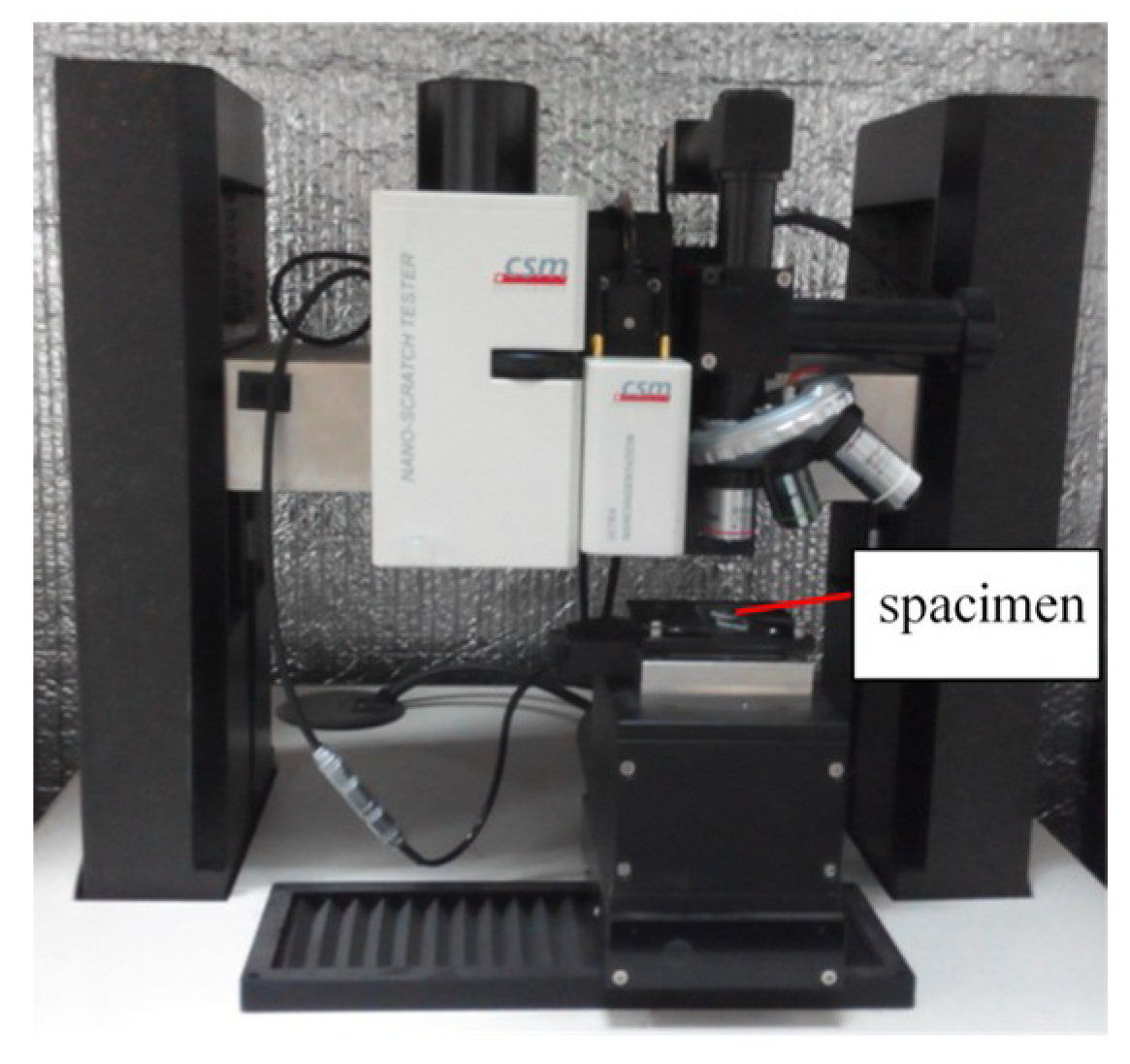


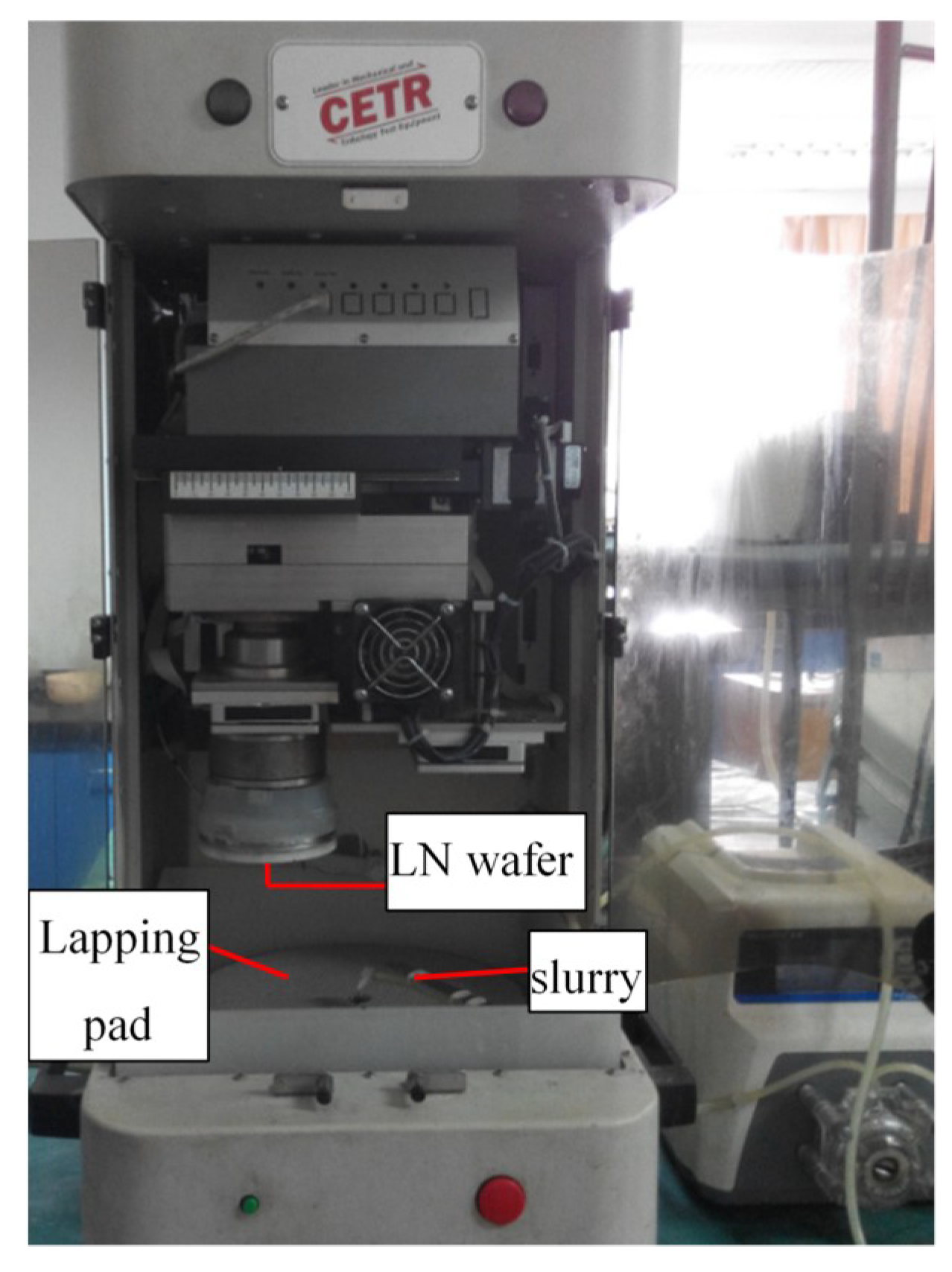

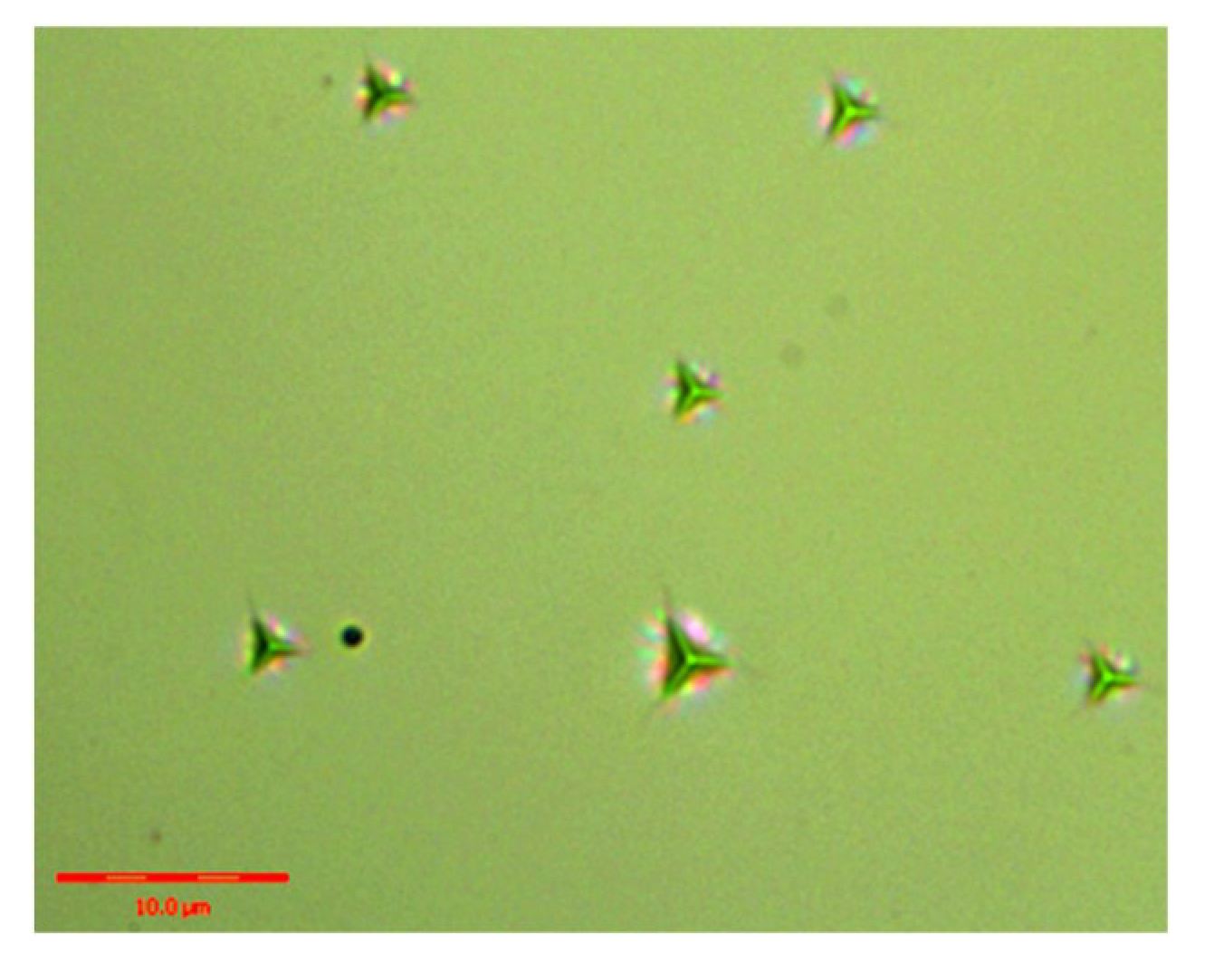
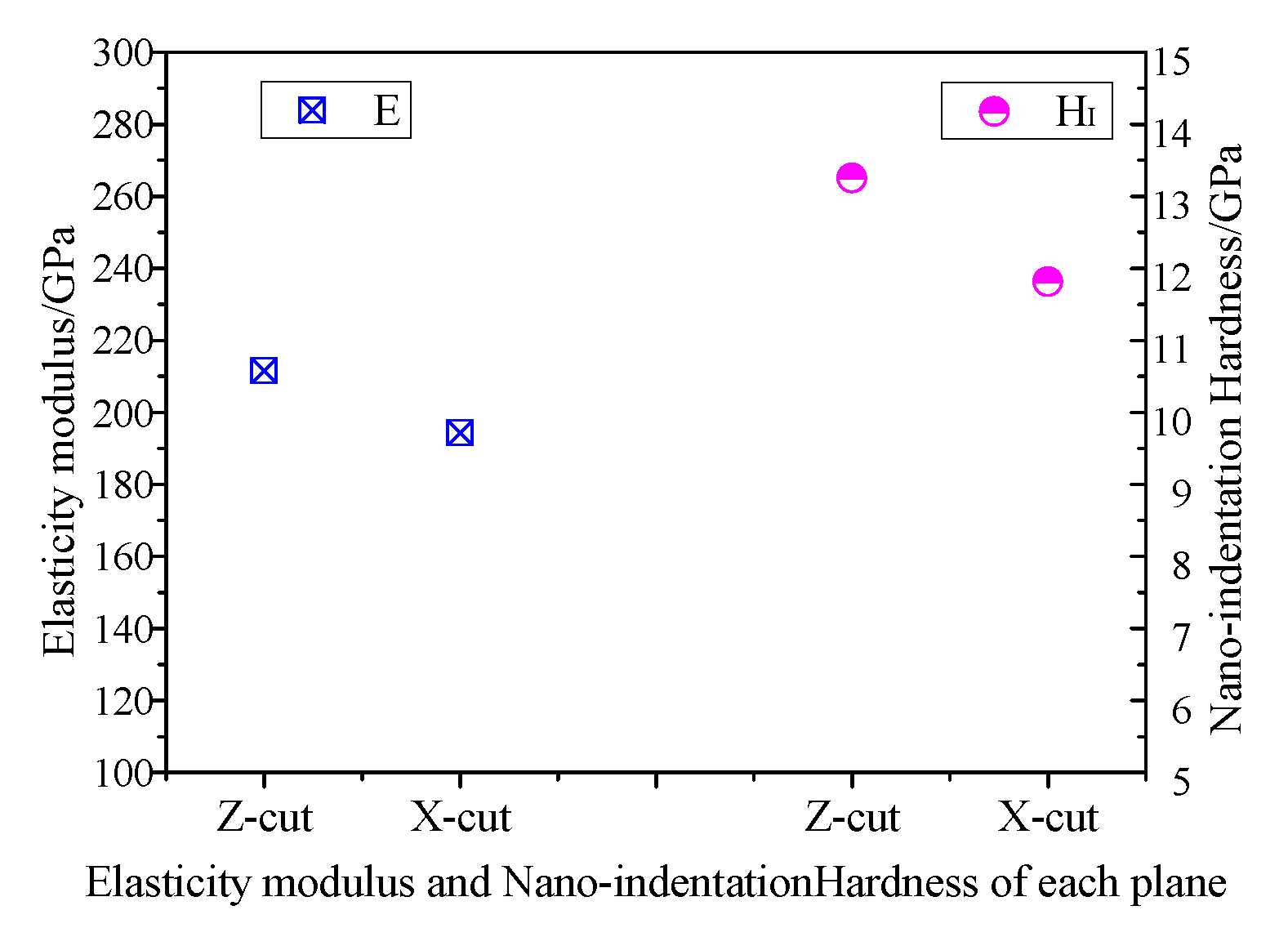




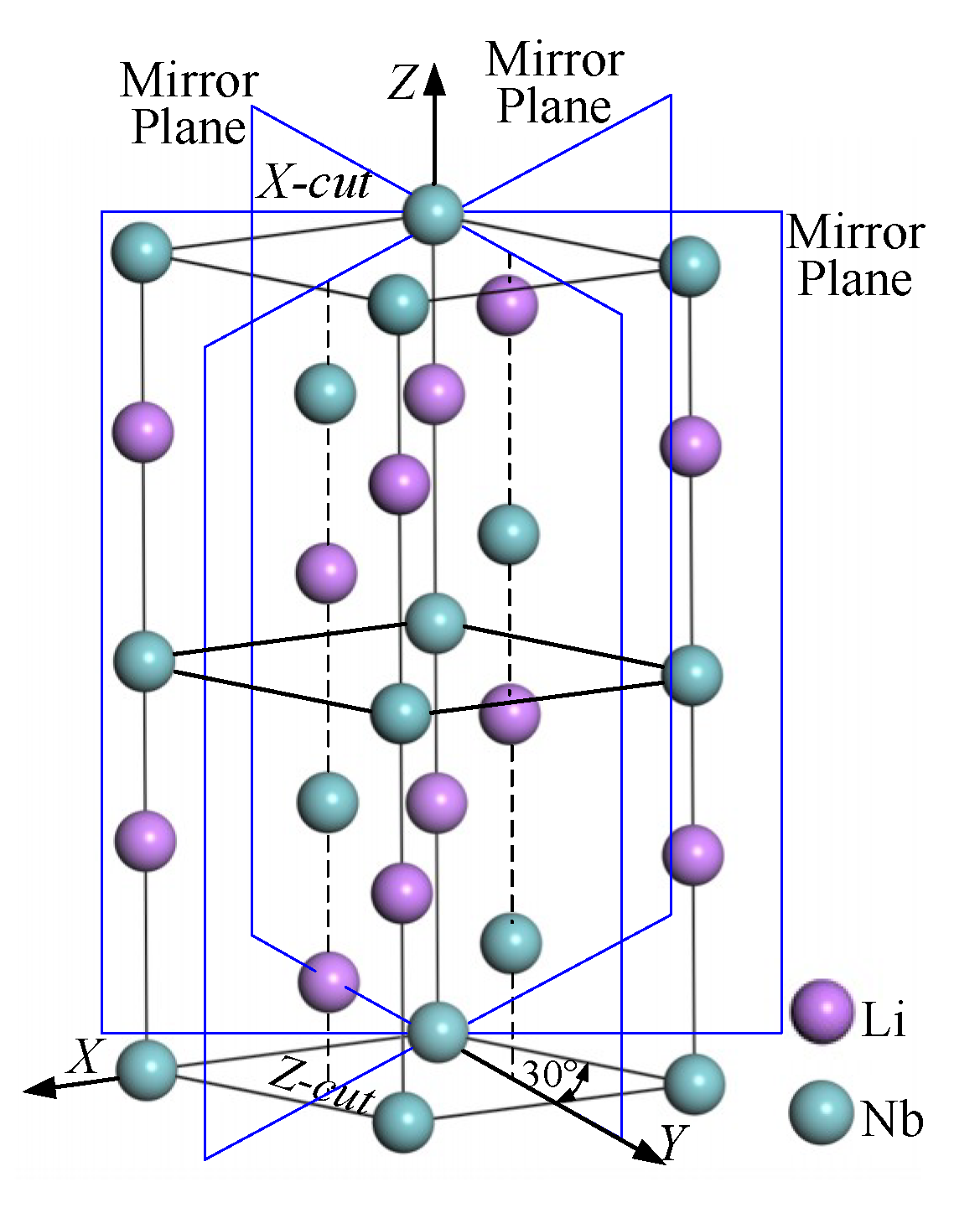
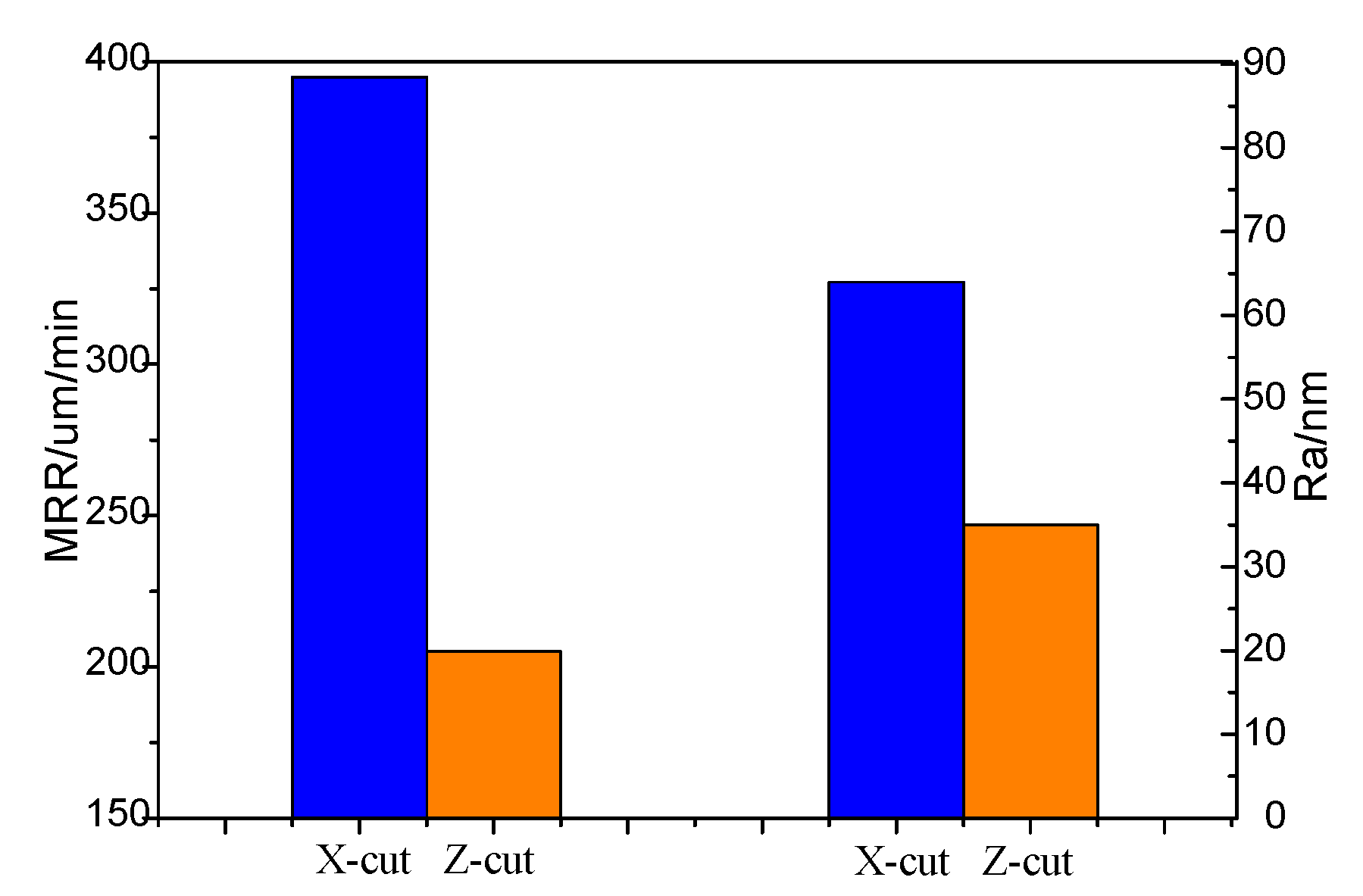
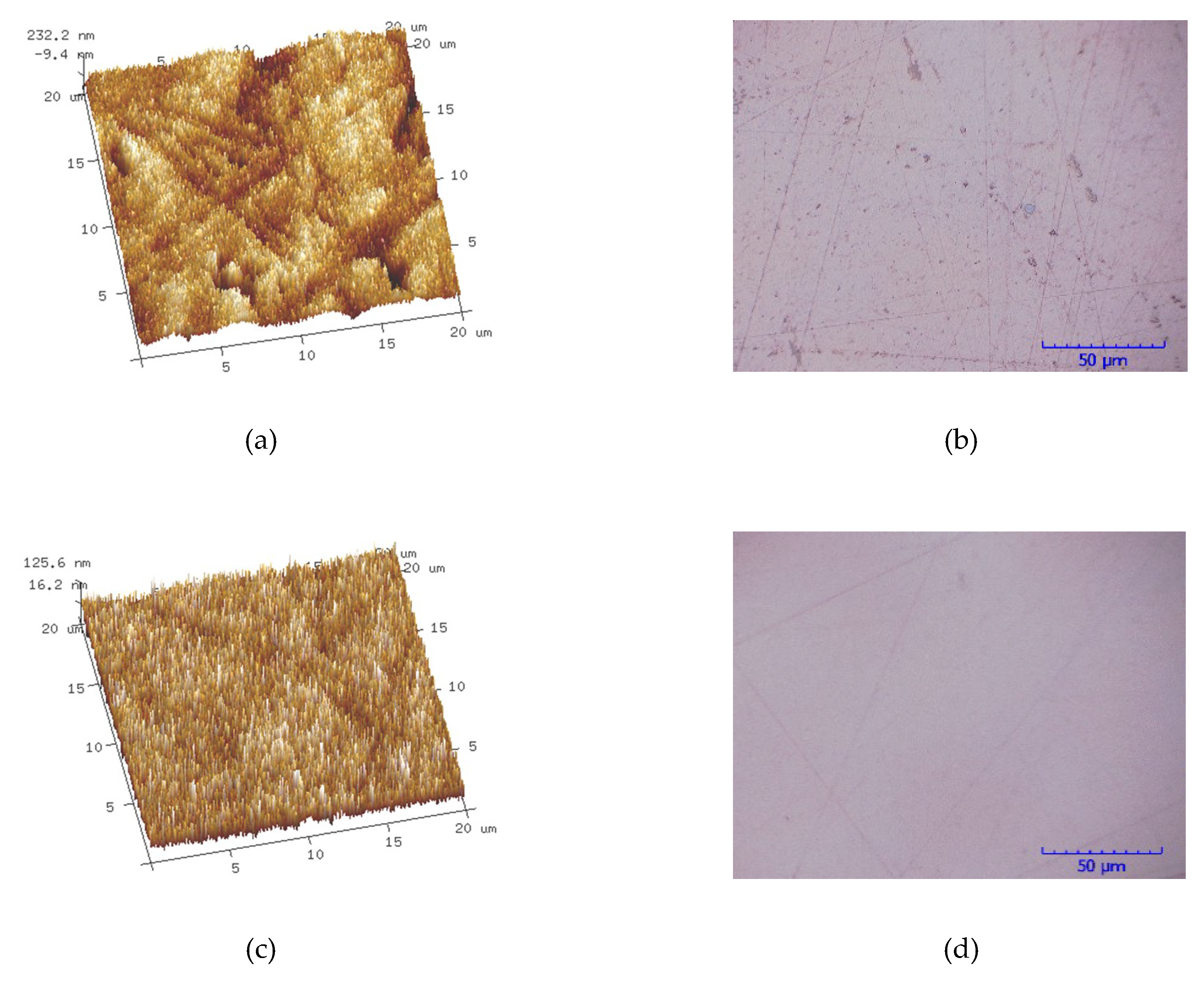
| Scratch Orientation | Transformation of Stage II-III/μm | dc/nm | Fc/mN | |
|---|---|---|---|---|
| Z-cut | X axis | 91.0 | 117.5 | 11.650 |
| Y axis | 60.4 | 66.3 | 7.878 | |
| X-cut | Y axis | 75.8 | 77.4 | 9.787 |
| Z axis | 44.0 | 36.2 | 5.888 | |
© 2020 by the authors. Licensee MDPI, Basel, Switzerland. This article is an open access article distributed under the terms and conditions of the Creative Commons Attribution (CC BY) license (http://creativecommons.org/licenses/by/4.0/).
Share and Cite
Zhu, N.; Chen, J.; Zhou, P.; Zhu, Y. Effect of the Anisotropy Mechanical Properties on LN Crystals Fixed-Abrasive Lapping. Materials 2020, 13, 4455. https://doi.org/10.3390/ma13194455
Zhu N, Chen J, Zhou P, Zhu Y. Effect of the Anisotropy Mechanical Properties on LN Crystals Fixed-Abrasive Lapping. Materials. 2020; 13(19):4455. https://doi.org/10.3390/ma13194455
Chicago/Turabian StyleZhu, Nannan, Jiapeng Chen, Piao Zhou, and Yongwei Zhu. 2020. "Effect of the Anisotropy Mechanical Properties on LN Crystals Fixed-Abrasive Lapping" Materials 13, no. 19: 4455. https://doi.org/10.3390/ma13194455
APA StyleZhu, N., Chen, J., Zhou, P., & Zhu, Y. (2020). Effect of the Anisotropy Mechanical Properties on LN Crystals Fixed-Abrasive Lapping. Materials, 13(19), 4455. https://doi.org/10.3390/ma13194455




